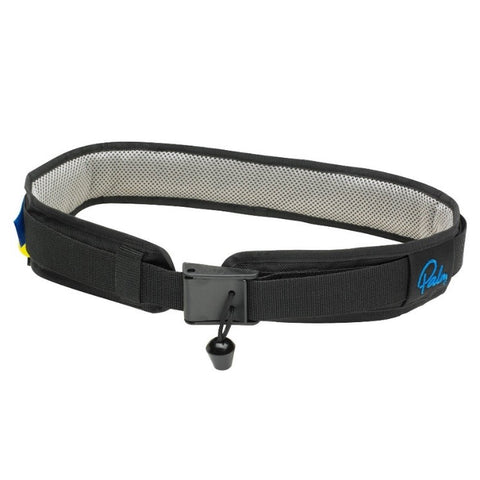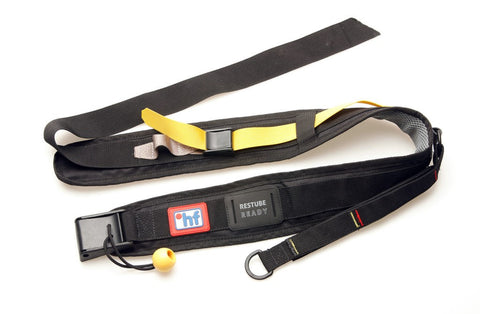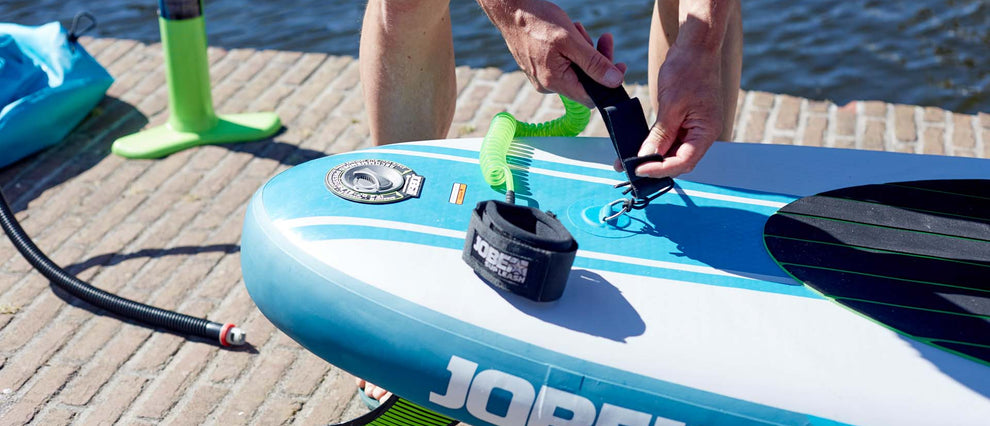There are many different ways to wear your SUP leash. In this short post I am going to explain these differences as well as go through some of the pros and cons.
Your leash is your primary source of safety when out paddle boarding and the way you wear it will depend on the environment your paddling in.
Ankle Leash:
This is the most common way to wear your leash and should come with your board as part of the package deal. It is super easy and simple to wear however, it can get in the way when moving around on the board e.g. doing a step back turn as it sits directly on the deck of the board.

Calf Leash:
Similar to an ankle leash but the cuff is slightly longer so you can attach your leash just below your knee. This gives you more freedom when moving about on the board as the leash is higher up and not sat on top of the deck of the board.
With both these styles of leashes they should not be worn in tidal and slow moving rivers and especially not in white water. Always try put your leash on the same ankle or calf every time you go paddle boarding, so if you do encounter any entanglement hazards you know which ankle to reach for to release your leash. However, if you get an ankle entrapment in moving water it will be near impossible to reach down and release yourself even in slow moving water.
You should put your leash on your dominate ankle or calf as this will be the foot you are most likely to use when doing a step back and therefore will not get in the way.
Where should we wear ankle and calf leashes?
- Open Water e.g. lakes, coastal bays and sea.
Quick Release SUP Leash:
This is a new style of quick release leash. It has a toggle which when pulled, opens a pin and releases you from the leash. This leash needs to be attached to somewhere whereby you can reach the red toggle with either hand to release yourself from the leash. Make sure you can do this whilst in the water by practicing in a safe environment with other people around you in case you do get into difficulty.

Waist Leash:
These are starting to become more common and is my chosen method when I paddle. The leash is connected to a quick release belt which you put on around your waist below your buoyancy aid or you can attach it via a carabiner to the safety harness on your white water buoyancy aid. By attaching your leash to a belt or safety harness it means if you have any entanglement issues you can separate yourself from the board.
On the tidal sections of the river Thames it is now compulsory that you must wear a leash on a quick release belt. If you fall off and your board goes one side of a bridge pillar and you go the other side, instead of the leash holding you under water, you can now free yourself from this very dangerous situation.
Having your leash set up like this gives you lots of freedom of movement on the board as there is zero drag on the deck of the board. Another bonus is that when walking, the leash doesn’t drag along the floor and get snagged up. If you do buy one of these, cut down the tail that goes through the buckle on the waist belt and make sure it’s a good fit to you and is tight on your body. Practice releasing the belt whilst in the water in safe environments and under supervision of others. (Seek advice from a local SUP center/shop/SUP coach about how to setup your belt correctly).
If your planning to use your waist belt for white water paddle boarding and are worried about entrapment or the waist belt keeps getting twisted here is an alternative way of wearing it. Some people prefer to wear their waist belts around their chest above the white water buoyancy aid. This means the toggle is right in front of their face rather than being hidden below their buoyancy aid. This allows easy access to release the belt and stops it twisting. If you are planning to do white water SUP I would strongly advise getting some coaching from an experienced white water SUP coach before buying any products.
Where should waist belts be used?
- Rivers
- Tidal races

An alternative style of waist leash is the HF Synergy quick release belt. This belt has two release mechanisms, the manual quick release system on the front and a failsafe, adjustable, emergency release on the back of the belt which is held in place using Velcro but as soon as enough force is being put through it, the Velcro rips away releasing the leash from your belt.

Over the next few weeks, I will be continuing with this theme about leashes by writing posts about:
- What type of leash you should buy? Straight or coiled?
- How to attach your leash to your board.
- How to adapt a leash to have a carabiner attached to it.
Words by: Joshua Telling (Rapid Skills)
Contributions from:
Tom Botterill (Rapid Skills)
Matt Stephenson (Matt Stephenson Coaching)
Kathy Marston (Happiest When Outdoors)





Join the discussion 0 Comments